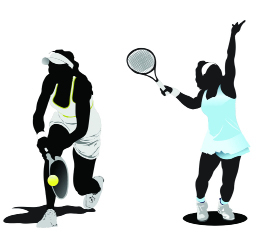Lesson 2: Relations
Module 4: General Relations
Lesson 2: Relations

Hemera/Thinkstock
Focus
Two of the best tennis players in recent history are sisters Venus and Serena Williams. As of 2010, Venus, the older sister, has won 21 Grand Slam titles and three Olympic gold medals. Younger sister Serena Williams has won 27 Grand Slam titles and three Olympic gold medals. Both sisters have been ranked as the best female tennis player in the world on many occasions by the World Tennis Association.
Some of the most exciting tennis matches have been those where the sisters squared off in a Grand Slam final! Grand Slam events include the French Open, the Australian Open, the United States Open, and Wimbledon.
Examples of athleticism in families are also found in other sports. Whether it’s the Sutter hockey family from Alberta or the Reed figure skating family or the Manning American football family, each example makes a good case for athletic talent. In many cases, this talent has been passed on from one generation to the next.
Many people are interested in genealogy, or the study of family ancestry and histories. Genealogy involves the creation of family trees. A family tree allows you to see not only who you are related to, but how you are related to other people.
Consider the following family tree. How is Sarah related to Ann and Paul? to Emily? to George? to Amelia? to Henry and Dianna? to William and Mary?

In this lesson you will work with mathematical relations.
Outcomes
At the end of this lesson, you will be able to
-
explain why data points should or should not be connected on the graph for a situation
-
determine and express, in a variety of ways, the domain and range of a graph, a set of ordered pairs, or a table of values
-
graph, with or without technology, a set of data and determine the restrictions on the domain and range
Lesson Questions
-
Why is it appropriate to connect the points on some graphs but not others?
-
How can you determine any limitations on the domain and range of a relation?
 Lesson Assessment
Lesson Assessment
As you work through each lesson, complete all the questions and learning activities in your binder using paper and pencil, clearly labeling your work (they refer to this as your course folder). These include the Are you Ready, Try This, Share and Self Check questions. Check your work if answers are provided. Remember that these questions provide you with the practice and feedback that you need to successfully complete this course.
Once you have completed all of the learning activities, take the Lesson Quiz. This is the assessment for each lesson and is located under the Assess tab or by using the Quizzes link under the Activities block.
** Note – Share questions may have to be done on your own depending on your learning situation**